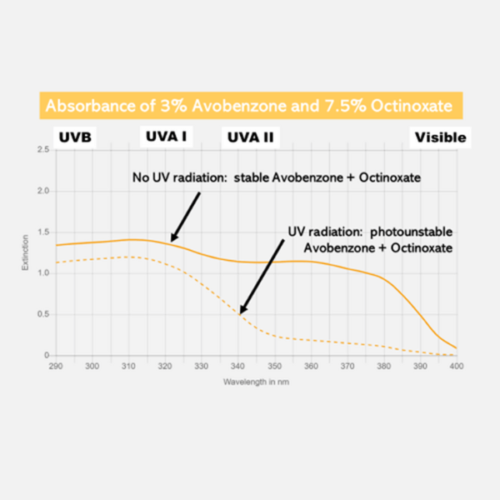On #Sephora’s bestselling sunscreen list, the entrant at no 11 is Paula’s Choice Mini RESIST Youth-Extending Daily Hydrating Fluid SPF 50.
I’m so pleasantly surprised that the sunscreen filter combination has been a non-issue….until now. The UV filters in this sunscreen are:
Avobenzone 2%, Octinoxate 7.5%, Octisalate 5%, Octocrylene 2%
In today’s note, I will focus on why this looks like an unstable sunscreen filter combination to me.
1) But first, a primer on #Avobenzone
Avobenzone is a superior #UVAfilter: it provides excellent protection against UVA, especially in UVA I spectrum. In the USA, there are 2 options for protection against UVA – either Zinc Oxide or Avobenzone. Both cannot be combined, and the max. permitted amount is 3% in the USA.
Avobenzone is best described as a diva – her output is impeccable, provided it is stable. The US FDA summarises: “Avobenzone exhibits greater photoinstability than other UV absorbers; the available evidence shows that avobenzone degrades quickly upon exposure to sunlight, which can cause its efficacy to be decreased by between 50 and 90 percent after 60 minutes of exposure to sunlight.”
(Source: Sunscreen Drug Products for Over-the-Counter Human Use (A Proposed Rule by FDA (2019)
2) Stabilising Avobenzone
Outside the USA, I modern UV filters such as BEMT and DHHB stabilise Avobenzone, but these are non-options in the USA, so I expect Octocrylene and/or Oxybenzone (which is not in the formula). Octocrylene is not present in sufficient quantity to stabilise Avobenzone – Octocrylene typically needs to be present in the 7%-10% range to provide adequate stability.
3) How about Diethylhexyl Syringylidenemalonate?
I’ve only ever come across this as a UV absorber that protects colour in formulas. It also is a potent anti-oxidant but I don’t think that’s sufficient to stabilise the Avobenzone in the formula.
4) The role of Octinoxate
The sunscreen also has Octinoxate, which destabilises both Avobenzone and Octinoxate. See the graph below.

The solid orange line shows the stable formulation when there is no UV radiation. The dotted orange line shows what happens when the sunscreen is exposed to UV radiation (1 MED). As you can see, the filters are photo-unstable. They essentially breakdown, providing the wearer with extremely poor protection against UVA and UVB radiation
See also Dondi D, Albini A, Serpone N. Interactions between different solar UVB/UVA filters contained in commercial suncreams and consequent loss of UV protection. Photochem Photobiol Sci. 2006 Sep;5(9):835-43. doi: 10.1039/b606768a. Epub 2006 Aug 3. PMID: 17047836.
#happyskindaysblog, #SunscreenReview, #SkincareAnalysis, #UVProtection, #BeautyBlog, #SunscreenScience, #SkincareRoutine, #SPF50, #SunscreenIngredients, #PaulasChoice, #AvobenzoneStability, #SkincareTips, #SunscreenEducation, #UVAProtection, #SunscreenFilters, #SkincareResearch, #BeautyScience, #SkinHealth, #SunSafety, #SkincareObsessed, #BeautyInsights,